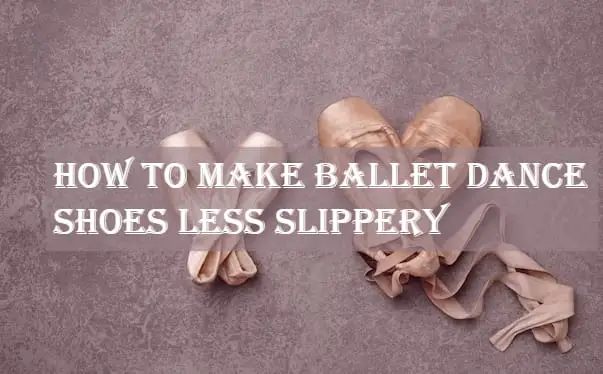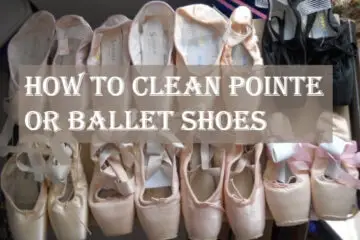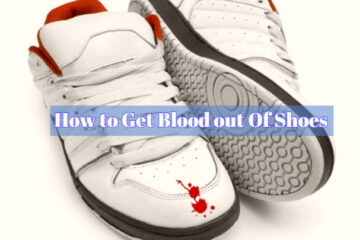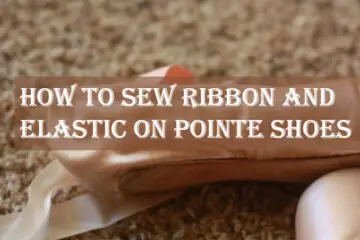As a lifelong ballerina, I know the struggle with slippery pointe shoes all too well. One moment you’re gracefully floating across the stage, the next you feel like Bambi on ice! While it’s impossible to completely prevent slippage, there are tricks I’ve learned over the years to give you a better grip. Read on for my top tips to make pointe or ballet shoes less slippery!
Why Do Pointe Shoes Get Slippery?
Pointe shoes are designed for dancing en pointe, with all your body weight on the tips of the toes. The shoe’s box and shank give the structure and support to achieve this beautiful extended line. However, the materials that make up a pointe shoe’s sole are purposely slick. This allows the foot to slide and roll through positions more fluidly. A grippy sole would restrict movement.
The satin outer sole in particular has no traction. Combine this slippery satin with the highly-polished dance studio floor and you have a recipe for sliding around. This makes balancing en pointe even more challenging. As the shoe becomes worn in, the satin also loses its luster, becoming smoother and slicker. That’s why pointe shoes need to be constantly broken in and maintained for optimal performance.
While some slipping is normal, too much can hinder technique and even risk injury. So let’s look at solutions to keep dancers on their toes, not their tush!
9 Clever Ways to Make Ballet Shoes Less Slippery
Now let’s get into the fun stuff – my 9 favourite tricks to transform slippery ballet shoes into traction queens!

1. Check the Dance Floor
Pay attention to which studio floors give you the most trouble. Wood floors with lacquer finishes tend to be most slippery. See if you can test out different spaces to determine which provide the best grip. Avoid wearing pointe shoes outside on pavements or anywhere gritty, as this will ruin the satin.
2. Dampen the Soles
One of my go-to tricks is to lightly dampen the soles with water before class. A barely moist sole will provide just enough tackiness when it dries, without compromising the structure. Spritz or wipe the soles evenly. Test on a small area first to ensure the satin doesn’t spot or stain.
3. Find Shoes that Fit Your Feet Well
An improperly fitted shoe leads to slipping off pointe as you struggle to keep it on. Have an experienced fitter size you accurately. Accounts from real dancers on sites like Pointe Magazine’s forum can help identify the right shoe for your foot’s shape. Avoid too narrow or shallow a box. Proper alignment and support reduces excess sliding.
4. Sandpaper Method
Take fine-grain sandpaper, between 180-600 grit, and gently buff the soles and edges. This slightly roughens the satin for better traction. Go lightly and avoid scuffing the fabric. Check after a few swipes – less is more with this method.
5. Try Rosin
This sticky resin rubbed on violin bows works wonders. Apply a light dusting to the sole’s ball area using rosin powder or cake. It adheres lightly to the satin when pressed down. Avoid slippery patches by reapplying before each wear. Rosin can leave dusty residue on studio floors, so contain the mess.
6. Try Grip Pads
These sticky pads can be purchased to stick onto the sole where the box meets the shoe upper. Look for ones specially sized to pointe shoe soles. Many come already pre-cut into shapes like hearts or flowers. Position them near the widest part of the box. When placed carefully, they shouldn’t rip off chunks of satin when removed.
7. Try Water Soluble Glue
This is a neat trick I recently came across. Apply a thin layer of kid-safe, water-soluble glue onto the sole and let dry completely. It washes off with water when you’re done dancing. The glue adds tackiness while protecting the satin underneath. Just ensure you give it ample time to dry first.
8. Remove Excess Hair
Hair spray and ballet bun secrets like silicone bands grip the satin sole something fierce! Remove strands hanging by your neck and any spritzed flyaways along the hairline to avoid “ponytail traction.” This decreases the chances of sticking then slipping.
9. Is It Time to Retire Your Shoes?
If the sole feels dangerously smooth or slippery still after trying these tips, the shoe may simply be overworked. Monitor wear and retire pointe shoes every 30-80 hours of use. Damaged shoes deteriorate grip and put you at risk of injury. Discuss your shoe lifespan with your teacher.
Pointe shoes will always have some element of slickness, but hopefully these pointers help you gain a bit more control. Stay patient through the frustrating slip ups and keep practising proper technique. With time, your foot and ankle strength will improve to better handle those slippery satin soles! Let me know in the comments below if you have any other anti-slip tricks I should try. Happy dancing!
Conclusion
Slippery pointe shoes are a rite of passage for ballerinas. But small adjustments like damping soles, using rosin, and replacing worn shoes can help reduce sliding. Focus on building strong technique and foot muscles through your dance training as well. With patience and the right troubleshooting, you’ll be able to balance and move en pointe with grace and confidence.
Frequently Asked Questions
Can I rough up the soles or add traction pads?
Light sandpaper buffing or grip pads are options, but take care not to damage the satin. Only make minimal alterations to avoid restricting movement.
Should I wear pointe shoes outside to break them in?
Avoid wearing pointe shoes on rough or gritty outdoor surfaces as this can damage the sole and structure. Break shoes in properly inside the studio.
Is slipping always bad technique?
Not necessarily! Some sliding is normal, especially as beginners build strength. But excessive slipping signals ill-fitted or worn shoes.
Can I use hairspray on pointe shoe soles for traction?
Hairspray would damage the satin. Try rosin instead for light grip. Remove any hairspray residue along hairline.
Should I buy a harder or softer shank for less slipping?
The shank affects support, not traction. A properly fitted and aligned shoe is key, not the hardness.
Do certain pointe shoe brands or models grip better?
Traction varies more by fit and break-in. Search dancer reviews to see if any brands work well for your foot type.
Is there a way to permanently rough up the soles?
Permanent alterations like gluing on sand aren’t recommended as they drastically change the shoe’s performance and feel.
Can I put sticky tape on the bottom of pointe shoes?
Tread cautiously with tape as removing it may damage the satin. Try smaller grip pads instead.
Should I glue the inside of slipper shoes to keep from sliding?
No, gluing the interior can cause painful blistering and alter the fit. Snugly fitted ballet slippers shouldn’t slide up and down feet if properly laced or drawn. Place water-soluble glue only on the exterior sole surface to add traction and prevent sliding on the floor.
How often should I rosin my ballet shoes?
Only a very light dusting of rosin is needed before dancing, so shoes don’t need rosin at every wear. For performances or slick surfaces, apply rosin right before dancing for temporary traction. During rehearsals, add rosin if you notice sliding. Overuse makes floors gritty so use sparingly.




